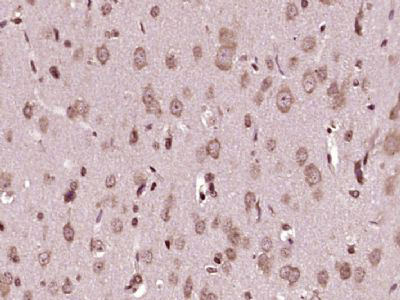产品货号 : mlR7877
英文名称 : NEDD4
中文名称 : 神经前体细胞发育下调蛋白4抗体
别 名 : Cell proliferation-inducing gene 53 protein; E3 ubiquitin protein ligase Nedd4; E3 ubiquitin-protein ligase NEDD4; KIAA0093; NEDD 4; NEDD-4; Nedd4; NEDD4_HUMAN; Neural precursor cell expressed developmentally down regulated 4; Neural precursor cell expressed developmentally down-regulated protein 4.
研究领域 : 细胞生物 神经生物学 信号转导 细胞周期蛋白 细胞分化
抗体来源 : Rabbit
克隆类型 : Polyclonal
交叉反应 : Human, Mouse, Rat, Chicken, Dog, Pig, Cow, Horse, Rabbit,
产品应用 : WB=1:500-2000 ELISA=1:500-1000 IHC-P=1:400-800 IHC-F=1:400-800 Flow-Cyt=3ug/test ICC=1:100-500 IF=1:100-500 (石蜡切片需做抗原修复)
not yet tested in other applications.
optimal dilutions/concentrations should be determined by the end user.
分 子 量 : 145kDa
细胞定位 : 细胞浆 细胞膜
性 状 : Lyophilized or Liquid
浓 度 : 1mg/ml
免 疫 原 : KLH conjugated synthetic peptide derived from human SRD5A2:801-900/1319
亚 型 : IgG
纯化方法 : affinity purified by Protein A
储 存 液 : 0.01M TBS(pH7.4) with 1% BSA, 0.03% Proclin300 and 50% Glycerol.
保存条件 : Store at -20 °C for one year. Avoid repeated freeze/thaw cycles. The lyophilized antibody is stable at room temperature for at least one month and for greater than a year when kept at -20°C. When reconstituted in sterile pH 7.4 0.01M PBS or diluent of antibody the antibody is stable for at least two weeks at 2-4 °C.
PubMed : PubMed
产品介绍 : E3 ubiquitin-protein ligase which accepts ubiquitin from an E2 ubiquitin-conjugating enzyme in the form of a thioester and then directly transfers the ubiquitin to targeted substrates. Involved in the pathway leading to the degradation of VEGFR-2/KDFR, independently of its ubiquitin-ligase activity. Monoubiquitinates IGF1R at multiple sites, thus leading to receptor internalization and degradation in lysosomes. According to PubMed:18562292 the direct link between NEDD4 and PTEN regulation through polyubiquitination described in PubMed:17218260 is questionable. Involved in ubiquitination of ERBB4 intracellular domain E4ICD. Involved in the budding of many viruses. Part of a signaling complex composed of NEDD4, RAP2A and TNIK which regulates neuronal dendrite extension and arborization during development. Ubiquitinates TNK2 and regulates EGF-induced degradation of EGFR and TNF2.
Function:
E3 ubiquitin-protein ligase which accepts ubiquitin from an E2 ubiquitin-conjugating enzyme in the form of a thioester and then directly transfers the ubiquitin to targeted substrates. Involved in the pathway leading to the degradation of VEGFR-2/KDFR, independently of its ubiquitin-ligase activity. Monoubiquitinates IGF1R at multiple sites, thus leading to receptor internalization and degradation in lysosomes. Ubiquitinates FGFR1, leading to receptor internalization and degradation in lysosomes. According to PubMed:18562292 the direct link between NEDD4 and PTEN regulation through polyubiquitination described in PubMed:17218260 is questionable. Involved in ubiquitination of ERBB4 intracellular domain E4ICD. Involved in the budding of many viruses. Part of a signaling complex composed of NEDD4, RAP2A and TNIK which regulates neuronal dendrite extension and arborization during development. Ubiquitinates TNK2 and regulates EGF-induced degradation of EGFR and TNF2.
Subunit:
Interacts with UBE2D2. Binds SCNN1A, SCNN1B and SCNN1G. Binds, in vitro, through the WW2 and WW3 domains, to neural isoforms of ENAH that contain the PPSY motif. Interacts with BEAN1, LITAF, RNF11, WBP1, WBP2, TMEPAI and PRRG2 (By similarity). Interacts with NDFIP1 and NDFIP2; this interaction activates the E3 ubiquitin-protein ligase and may induce its recruitment to exosomes. Interaction with PTEN is questionable according to PubMed:18562292. Interacts with viral proteins that contain a late- budding motif P-P-P-Y. This interaction is essential for viral particle budding of a lot of retroviruses, like HTLV-1 Gag and MLV Gag. Interacts (via C2 domain) with GRB10 (via SH2 domain). Interacts with ERBB4. Interacts with TNIK; the interaction is direct, allows the TNIK-dependent recruitment of RAP2A and its ubiquitination by NEDD4. Interacts (via WW3 domain) with TNK2; EGF promotes this interaction. Interacts (via WW3 domain) with FGFR1 (via C-terminus).
Subcellular Location:
Cytoplasm. Cell membrane; Peripheral membrane protein. Note=Recruited to the plasma membrane by GRB10. Once complexed with GRB10 and IGF1R, follows IGF1R internalization, remaining associated with early endosomes. Uncouples from IGF1R-containing endosomes before the sorting of the receptor to the lysosomal compartment. May be recruited to exosomes by NDFIP1..
Post-translational modifications:
Auto-ubiquitinated.
Similarity:
Contains 1 HECT (E6AP-type E3 ubiquitin-protein ligase) domain.
Contains 4 WW domains.
SWISS:
P46934
Gene ID:
4734
Important Note:
This product as supplied is intended for research use only, not for use in human, therapeutic or diagnostic applications.
产品图片












